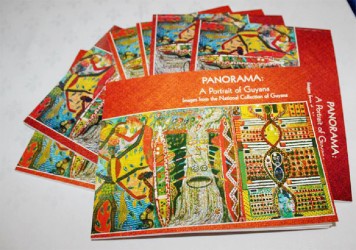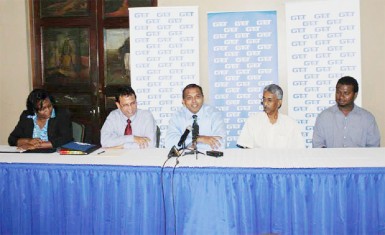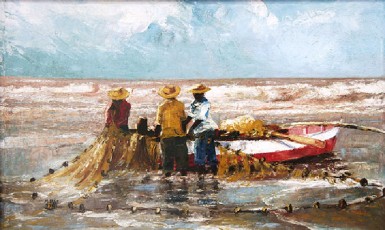(Alim A Hosein is Dean of Education and Humanities at the University of Guyana; a linguist, artist, literary and art critic; Convenor of the Guyana Visual Arts Competition and Exhibition; Member of the Management Committee of the Guyana Prize for Literature)
By Alim Hosein
A book of artwork titled Panorama – A Portrait of Guyana was launched at Cara Lodge on Monday January 12. This publication, which features artwork from the National Collection of Guyana, is the result of a partnership between the Guyana Telephone and Telegraph Company (GT&T) and the Ministry of Culture, Youth and Sport to produce a series of such books. This agreement will, to some extent, realise a project that has been mooted for some time—making available the works of the national collection, housed in the National Art Gallery, Castellani House, for viewing by the wide public and providing more-or-less permanent images of the works.
The partnership agreement was signed in the first half of 2014, and calls for the production of three books over three years, that is, one book per year. GT&T undertook to provide the funding, while the Ministry of Culture is responsible for the design, materials and production of each book.
 Minister of Culture, Youth and Sport Dr Frank Anthony noted that the books will be of “tremendous educational benefit” to the nation, and will help to make the national collection accessible as never before, by “opening the various facets of Guyanese creativity to the world” even though the three books will only cover a small portion of the national collection’s over 1,200 pieces. The minister also pointed out that the publication of the book will indirectly yield another benefit, and that is, the digitisation of the national collection. The digital form of the book will be placed online.
Minister of Culture, Youth and Sport Dr Frank Anthony noted that the books will be of “tremendous educational benefit” to the nation, and will help to make the national collection accessible as never before, by “opening the various facets of Guyanese creativity to the world” even though the three books will only cover a small portion of the national collection’s over 1,200 pieces. The minister also pointed out that the publication of the book will indirectly yield another benefit, and that is, the digitisation of the national collection. The digital form of the book will be placed online.
CEO of GT&T R K Sharma noted that GT&T placed great value in such collaboration with the ministry because of its recognition that the arts “foster creative inspiration, promote cross-cultural dialogue, and understanding, bring important social issues to the fore and foster good-will and collaboration among various sectors of society,” in addition to nurturing critical-thinking skills, bolstering academic success and preparing young people for the world of work. Deputy Curator of Castellani Ohene Koama remarked that the production of such books was a longstanding dream of the gallery.


A team comprising Alim Hosein, Philbert Gajadhar, Ohene Koama and Jynell Osborne considered a number of designs and themes for the books and decided to begin with a wide view of Guyana as reflected through the art work. For the first book, the theme of “Panorama” was chosen. This is based on an exhibition of the same name and theme mounted by Castellani House in 1996, curated by Elfrieda Bissember. However, the book considerably updates and supplements this by including more images than shown in the exhibition so as to reflect more themes and more aspects of Guyanese life, and by the inclusion of more contemporary work.
Of course, the book is also structured differently from the exhibition, and its arrangement creates another dimension in presenting Guyana. It starts with Terence Roberts’ Birth of Guyana and Aubrey Williams’ Guyana, two fantastic and galactic images of birth and history. From here, a variety of themes reflecting life in Guyana flow easily through the book by way of the artwork: festivals, work, traditions, lifestyles, occupations, everyday life, the landscape, spirituality, history, celebrations, people, struggle, resistance, ethnic connection, social commentary, and more. The book ends with fertile, hopeful images of woman, love, and the power of all the ancestral wisdom contained in the land.
The original proposal envisaged a book of 42 images. The final book contains 68 images. But the book is not meant to be a mere album of pictures. While the artwork is given prominence, each image is accompanied by a short description, which serve not only to assist those who are unfamiliar with Guyana, its artists or the artwork, but to offer various insights, comments and brief analyses of the works. Deliberately, there is no uniformity in these descriptions – some discuss the artist, some the context of the work, some analyse the techniques used, some offer interpretations, and so on, so that a varied account is given to the reader. The book also features a general introductory essay, and messages from Sharma and Anthony.


The National Collection of Guyana was initiated in the 1950s with public subscription being mustered to purchase the painting Human World by Denis Williams. When the National History and Arts Council was created in 1962 with the mandate to acquire artworks done by Guyanese, the Collection became an official pursuit. Then, in 1993, Castellani House was adapted from a place of residence to a National Gallery to become the home of the Collection. Castellani House has mounted many excellent exhibitions of works from the Collection since then, but as Anthony pointed out, since the Collection contains more than 1,200 pieces, it would take Guyanese art lovers a long time before they could see all these works.
Apart from giving glimpses of Guyana, Panorama also indirectly gives an idea of the historical development of Guyanese artwork, and shows various styles and approaches used by Guyanese artists. The artwork featured covers a wide array of paintings and sculpture, the two main genres of visual arts in Guyana. The oldest piece is E R Burrowes’s sculpture, Pomona, which was probably done in the 1930s or 1940s (it is undated), and is unique because it is executed in quartz.
All in all, Panorama is much more than a collection of images. In it, the observations of the GT&T CEO are reflected, and the functions envisaged by Anthony are realised. The book is a very pleasing production: it is a wholly local effort, from funding to design to content to physical production. It will prove to be not only an accessible introduction to the National Collection and an encouragement for all to visit the actual gallery, but also a bolster to national pride, and a good resource book for students.





